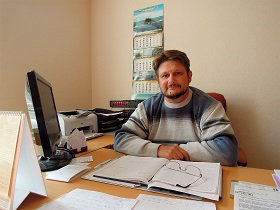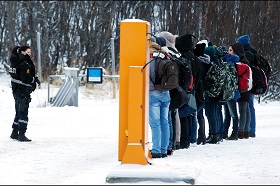Norway has begun the construction of a wall along the Norwegian-Russian border at the checkpoint Storskog–Borisoglebsky in a bid to prevent a new wave of migrants coming to Norway. Last winter more than 5,000 refugees entered the Nordic country from the Russian territory through the “Arctic route”. Will the measures halt the flow of migrants and how the construction of the wall on the Norwegian-Russian border will affect the relations between the two countries? RIAC asked Anders Kjellevold, Political advisor for the Labour Party in the Oslo City Council, and Dr. Andrey Repnevsky, Director of the International Relations and Russia’s Arctic Policies Educational and Research Center, Professor at the World History Department of Lomonosov Northern (Arctic) Federal University to comment on the situation.
Will the construction of a border fence between Norway and Russia limit the flow of migrants entering Norway and increase security in the country?
Anders Kjellevold: The fence is actually very short. It covers a distance of 200 meters right next to the border station Storskog, along a tiny stretch of the border. I find it unlikely that it will significantly affect the flow of migrants.
The Norwegian authorities justify the fence on the grounds that it will improve security at the border station. That might be the case, but none of the approximately 5500 asylum seekers that have come to Norway from Russia last year attempted to evade the station. Some critics therefore argue that the fence is unnecessary. If, however, the number of migrants at the border crossing was to increase considerably from last year’s peak, it might make things easier for the border guards.
The actual economic costs of constructing the fence are minor. There could still be considerable diplomatic costs IF there is a negative reaction from the Russian government. So far, this has not been the case.
I believe that domestic politics is part of the motivation behind the fence. Last winter, the number asylum seekers trying to get in to Norway from Russia caught the authorities unaware. As a result, the government faced a lot of criticism. In the current political situation, it is important for the government to show that it is control of the border. Constructing a fence might appeal to parts of the electorate.
Andrey Repnevsky: Strictly speaking, Norway’s authorities certainly may erect a fence on the country’s Russian border. Norway’s economy will not particularly suffer, even if they build it along all 196 kilometers of Norway–Russia land border. Mostly it is a water boundary along the waters and locks of the Paatsjoki River. This is a fairly deserted land, and in winter, if one does not stick to the roadways, snow and hills make the terrain impassable for regular people, and particularly for southerners. A skiing Syrian is something of a rather unfunny joke. There are watch towers along the border, and some wire fencing on the Russian side, but the fencing is intended to keep away deer, not people. The nature itself is a fence keeping away unreasonable people. This border is one of the quietest in Russia. There is only one border checkpoint for people and cargo: Borisoglebsk on the Russian side, Storskog on the Norwegian side. I used it many times. There is nothing to prevent Norwegians from sifting away right there and then those illegals who come there with “freshly minted” Russian citizenship.
Due to all these reasons, erecting a fence to contain refugees from Syria and other Arab countries is a pointless exercise. But if Norwegians want to build that fence, let them, it’s their country. I suppose they will build a rather short one, a few kilometers long on the approaches to the Borisoglebsk checkpoint.
The number of “refugees on bicycles” making their way via Murmansk into Norway is relatively small. In 2015, 250,000 people crossed the border going both ways, and only 5,500 did not come back to Russia, and for many of them, Norway was not their final destination. They were taking a roundabout way to the EU countries. Is it really worth all the song and dance?
Entire districts populated by people from the East emerged in Oslo and in other Norwegian cities much earlier than 2015 or 2016; an overwhelming majority (tens of thousands of migrants) did not arrive from Russia, but Norway did not build any fences along its borders with Finland and Sweden. Norway’s decision made in April 2016 to build a fence on the Russian border is “much ado about nothing.” It somewhat smacks of panic.
Does this decision mean that Norway has changed its attitude to migrants? Should we expect that Norway will refuse to accept migrants in the future?
Anders Kjellevold: As in the rest of Europe, the refugee crisis has affected the political climate in Norway. The increase in immigration has generated much debate, and immigration is now a much more important issue for voters than it was just a few years ago. This has played to the benefit of The Progress Party, part of the ruling coalition together with the Conservative Party, which advocates a restrictive migration policy. Indeed, the government has introduced measures to control immigration. There is a common understanding among the major political parties of the need to control the border.
However, these changes do not constitute a departure from the main principles of Norwegian refugee policy. The dominant political opinion is still that people in need of protection have the right to asylum in Norway. The domestic debate is about details, albeit important, such as the conditions for family reunification, faster processing of asylum applications and the repatriation of persons considered not to be refugees or persecuted in their native land. Norway will certainly accept refugees also in the future.
Andrey Repnevsky: The European society is deeply concerned and profoundly split on the migrant issue. The migration of millions of people belonging to a different culture essentially means a new Migration Period. In history, such migrations led to radical changes: wars raged, horrific diseases spread, great empires collapsed, civilizational patterns changed.
Europe and Norway have every reason to be concerned. But those countries’ politicians chose the wrong way to fight the common problem. Instead of a real fight against global terrorism which is the true cause of the refugee influx they declared a sanctioning crusade against Russia.
Let us remember all the crocodile tears the West shed over the Berlin wall, let us remember the triumphant West when the wall came down, and how the West celebrated the freedom of movement for nationals of all states. The fence-building which is now so popular in Europe and America and which is intended to keep away the throngs of poor migrants directly contradicts their professed bourgeois democratic principles. It applies to Norway, too, even though it is not an EU member.
Countries do not confine themselves to building fences, they take other measures as well. Citizens of Great Britain even voted “yes” to Brexit in order not to fulfill Brussels’ migrant quotas. Oslo even purchased advertisement space in Afghanistan media to convince people not to move to Norway, since they can be deported back. Norway is ready to pay 20,000 kroner (2,400 dollars) to each refugee who decides to go back home. But there are few who want to go back to being shelled and bombed.
If the refugee influx is not stopped, Norway, Sweden, and Finland will certainly pass laws against migrants. Human rights activists are concerned that Norway’s authorities may disregard the principles of the UN Convention Relating to the Status of Refugees.
Is Norway sending a negative signal of distrust to Russia by constructing the border fence? How will this affect Norwegian-Russian relations?
Anders Kjellevold: As a rule, the Norwegian government is wary not to deliberately commit acts that might damage relations between the two countries. This would jeopardize mutual gains made by previous governments, such as the maritime delimitation agreement and visa-free travel for the population in the border region. Therefore, I do not believe that the Norwegian government intended to stir up a reaction in Moscow by constructing the fence. Rather, as mentioned earlier, I believe the motivation is domestic – to show that the government is taking steps to control the border.
Whatever the intention – newspapers, former border guards and local notables have criticized the decision to build the fence. The reactions range from ridicule of the perceived pointlessness of such a short fence, to claims that it might unnecessarily provoke Russia. Local politicians in the border region are afraid the issue will hurt everyday cross-border cooperation. Many point out that there have been several negative reports in Russian media, which for some is enough proof that this was a bad piece of diplomacy. The fence has certainly generated a lot of debate.
It is worth noting that the decision to construct the fence became public knowledge as far back as April. In a recent interview, a Norwegian border commissioner said that they have kept frequent dialogue with their Russian counterparts about the fence. According to the commissioner, there have been no complaints. Neither has there been an official reaction from the Russian government. In other words – Moscow has known about the fence for a long time, and it does not seem to mind.
If the latter is true and the authorities are cooperating, this issue will not leave a lasting impression on Norwegian-Russian relations. I believe the standoff in January and February, when the respective governments argued about what to do with asylum seekers that had come from Russia to Norway, was a more serious issue. Back then, they reached an understanding. A new influx of refugees might again test the relationship. It is necessary to maintain a good dialogue to meet this challenge.
Andrey Repnevsky: Yes, it is a signal, and an undisguised one. A fence built on the Russian border is a political demonstration, and as such, it fits well with the overall anti-Russian policies of the Norwegian authorities that play along with the EU. In the fall of 2015, Norway’s largest NRK TV channel started airing “Occupied,” a series built around the premise of Russia occupying Norway. In addition, the media keep talking about the Russian aggression against Ukraine, Norway also imposed sanctions and refused to cooperate in developing polar oil and gas fields. The Kingdom of Norway fears an increase of migrants from Russia proper. The media promote this fear as they describe Russia’s economic difficulties. Apparently, the three-meter-high fence is intended to protect Norway from the “Russian threat.”
Even though in 2010, Russia made significant territorial concessions to Norway, and since then, there are no grounds for any disagreements between Russia and Norway in the Arctic, since January 2016, Norwegian experts keep discussing the need to enhance Norway’s defense due to the Russian threat. They consider Russia’s return into the Arctic waters and archipelagoes to be such a threat. Experts calculated that Norway would need about 2 billion kroner more in 2016 alone to counteract the Russian threat. Norway’s Minister of Defense Ine Eriksen Søreide stated several times that Russia–Norway relations deteriorated due to Russia’s “increasing aggression” in the Arctic. On June 18, 2016, Norway’s Prime Minister Erna Solberg announced the largest military modernization of the country since the Cold war. She also explained the need for the modernization by the “Russian threat in the Arctic.” Such policies could lead to a decline in economic, political and, most dangerously, cultural contacts and endanger all the positive achievements in our good neighborly relations since the late 20th century.
Mr. Kjellevold was speaking on his own behalf. Opinions shared in this article should not be understood as the official line of the Labour party.






